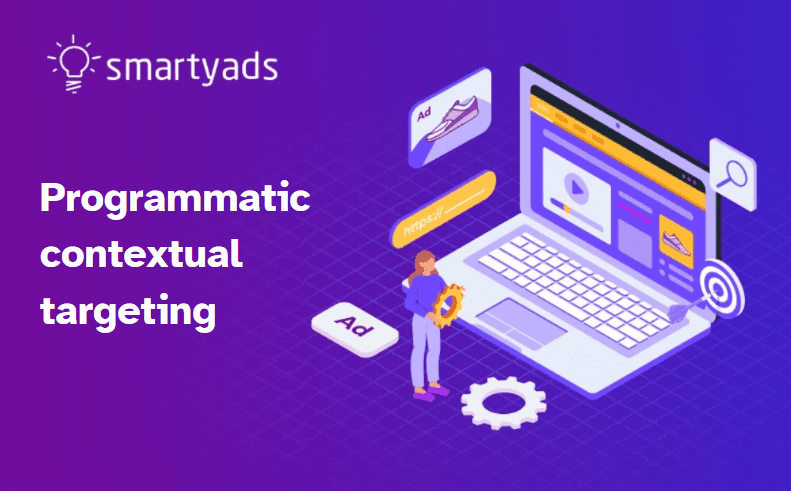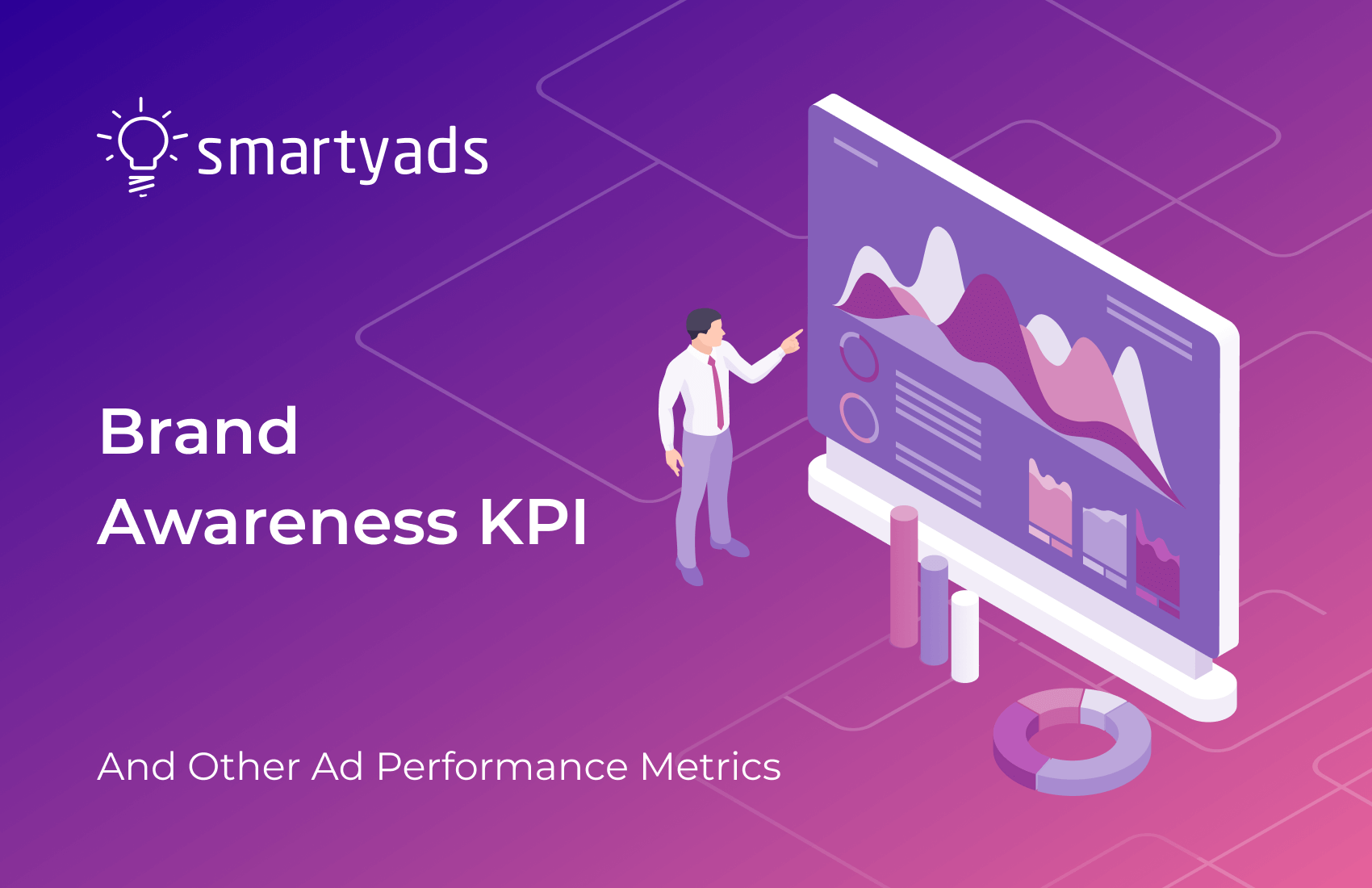Contextual targeting is still one of the best ways to serve ads and run campaigns without messing with audience data.
Contextual ad targeting method has changed digital advertising thanks to the power of artificial intelligence and the absence of third-party cookies. Meanwhile, programmatic advertising algorithms help move beyond relevant keywords search in online advertising.
Today, advertisers and agencies look to contextual ad as an essential tool for marketing. The IAB predicts that contextual advertising spending will increase to $297.68 billion by 2023 and $412 billion by 2025.
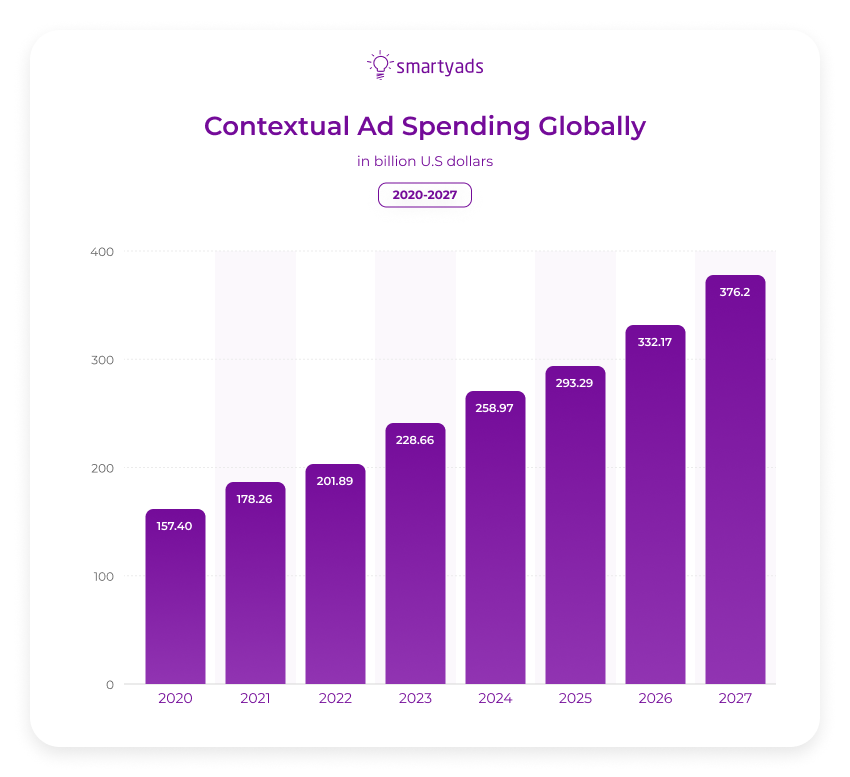
How Does Contextual Targeting Work?
Even before the Internet came along, print media actively used contextual advertising. Today, context-sensitive targeting works across all online formats and channels.
What is contextual advertising? For example, a user searches for information on a particular topic, and the algorithms display contextually relevant advertising. Contextual targeting lets you show advertisements that best match the content of the web page where it appears.
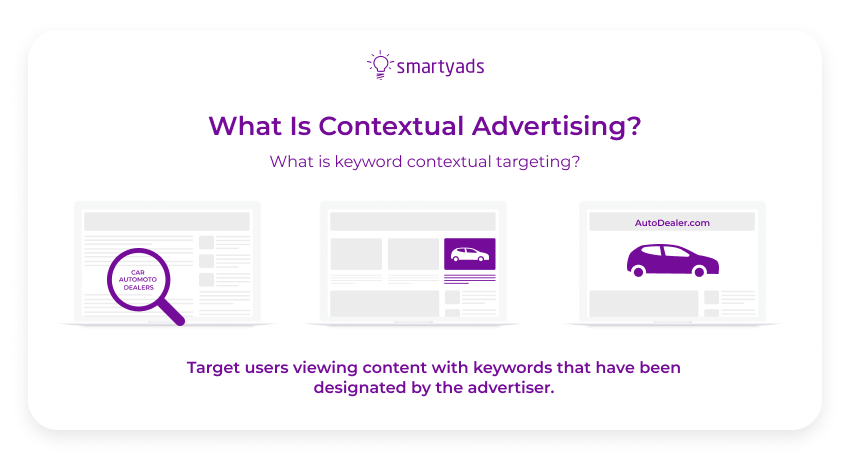
Contextual ad usually doesn't annoy users. It seems perfectly natural in a proper ad space. For example, a guy reads an article about the advantages of oils and sees advertisements for appropriate products with home delivery. A girl is studying tips on becoming a video blogger and sees an ad creative with a special lamp for good light for video shooting on this page.

Contextual & Behavioral Targeting: High-Value Customers
How does contextual targeting work? Contextual ad is based on what already falls within the user's interests (for sure).
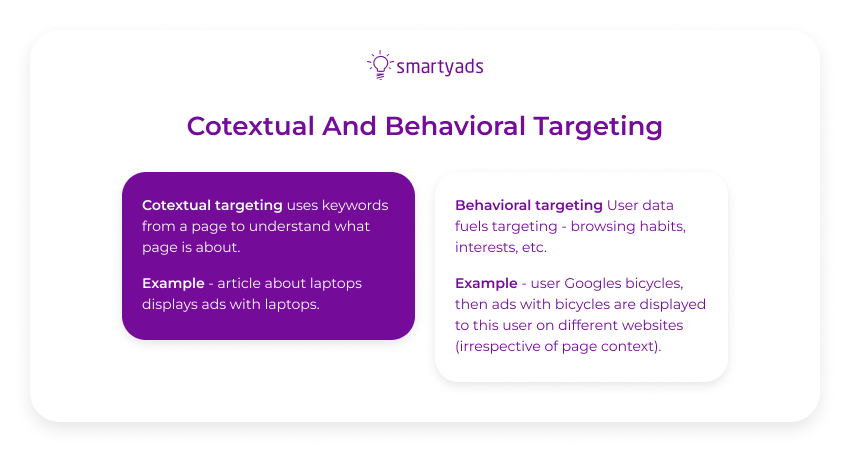
There are some advantages of contextual targeting:
- Brand-safe environment;
- The ad creative almost perfectly aligns with the surrounding context (especially video and native ads);
- The possibility of automating the buying and selling of contextual advertising.
Unlike behavioral targeting, contextual ad targeting is based on analyzing the content of landing pages. AI analyzes information such as websites visited by the user, search history, and content accessed. But contextual targeting in programmatic is more complex than keyword usage. Read more to find out.
Advantages of Contextual Advertising in the Post-Cookie Era
Contextual targeting has become more prevalent than behavioral targeting methods because of tightening regulations in ad tech and brand safety concerns.
The turning point is here — the rejection of cookies affects the entire process of purchasing algorithmic ads: personalization, tracking, measurement, and limitation of the frequency of printing. The whole advertising industry is looking at the future ahead without cookies. Marketers are actively testing and adding new solutions by combining digital advertising technology with more traditional targeting methods. It offers a whole range of targeting options.
Proximity to the Brand: Building Trust Through Context
There are valuable advantages to contextual targeting over behavioral targeting for brands. It lets marketers know exactly what products the customers are interested in. Therefore, the right brand message at the right moment creates a more meaningful user experience:
- 69% of consumers are most likely to see advertisements that are relevant to surrounding content;
- 67% reported that they would be willing to watch contextual ads relevant to new brands;
- 44% tried a new brand because they saw a contextually relevant ad besides some of the content they observed.
The same survey showed that 65% of consumers prefer brands that place advertising on a contextual basis.
People understand how advertising works and are more faithful to contextual ads. After all, they know they see those ads because they read relevant content, not because they are being tracked.
This is an opportunity to create positive associations with the advertisement.
GDPR and CCPA: Preparing For the Cookie-Less Future
Contextual ad is outside of radical changes in user privacy. This type of targeting allows marketers to comply with the GDPR and CCPA in full.
Adapting to a coming world without third-party cookies, advertisers have started to actively use first-party data and contextual ad targeting as alternatives. The first-party data started to be seriously referred to as the new oil.
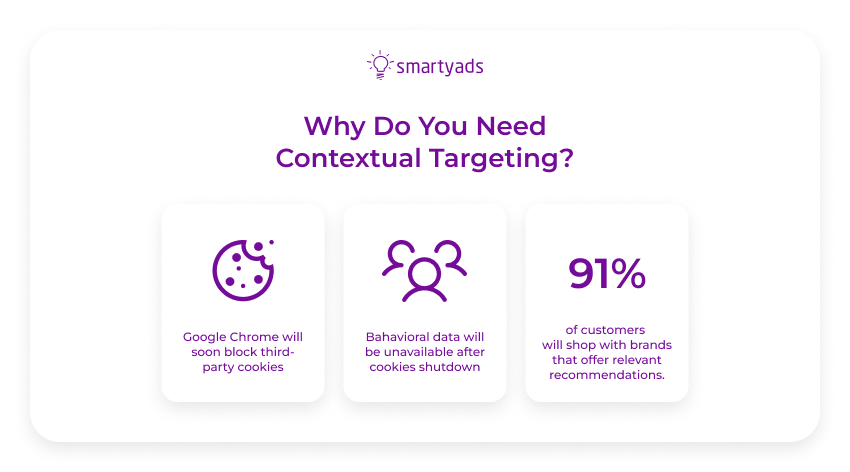
In addition, there are still doubts about personal data protection. For this reason, a recent study found that about 52% of US and UK marketers plan to invest more in contextual targeting.
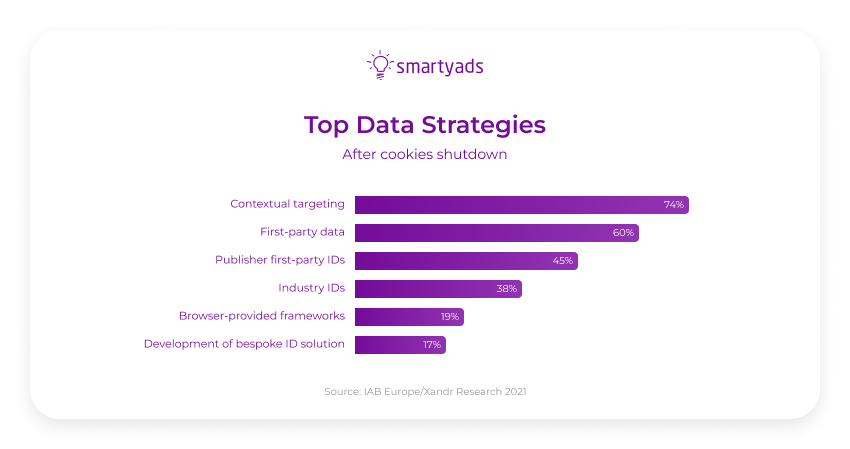
What does Contextual Campaign Allow Advertisers?
Contextual advertising lets you plan long-term marketing campaigns without worrying about changing privacy principles. The contextual platforms use the web page's content and determine the suitability of ads, not based on personal data. Moreover, contextual advertising is cost-effective.
Contextual targeting can be an important and effective privacy-focused marketing tool. Contextual advertising does not disrupt the online user experience but anticipates consumer needs.
Brand Security
Contextual advertising is a proven tool to gain brand recognition and commitment. Unlike behavioral targeting, contextual targeting focuses on users' current intents.
At the same time, European and American consumers are less likely to shop if a brand ad is placed in bad content. Marketers can't manually process millions of data points and determine the safety of a brand. But AI can.
But when ads only focus on the user's behavior or identity, it can sometimes be difficult to follow where the creative advertising will be displayed. Using programmatic advertisements gives you extra control over the brand's security.
Programmatic paired with contextual advertising makes it possible to place advertisements in an environment that perfectly fits the user's interests and is safe for the brand.

Contextual Targeting in Programmatic
Contextual targeting has undergone significant changes with the advent of AI. Using traditional contextual targeting alone, a brand cannot take the opportunity to present more personalized messages to its potential customers. Contextual targeting, in combination with programmatic potential, takes your advertising campaign to the next level.
Programmatic Advertising Ecosystem
Programmatic refers to the automated buying, selling, and serving of ads. With programmatic advertising, you purchase inventory from publishers automatically while the platform is leveraging AI to determine what kind of Internet users should see particular ads.
Here's how it works: publishers' inventory is connected to the SSP platform.
The Demand-Side Platform analyzes user information in SSP requests and matches it to targeting terms.
The DSP works on the advertiser's side and contains the ad creatives. Advertisers, on their side, define the target audience and set the settings for bids. Registering on the DSP allows advertisers to select specific targeting and start bidding.
Ad exchange platform processes information from both sides and allows advertisers to bid for ads.
OpenRTB is a real-time data exchange protocol between the two platforms.
Programmatic platforms automatically find suitable publishers and bid on their inventory instead of advertisers. If the bid wins, the ad of the advertiser will be shown. All of this takes only a split second.
In programmatic advertising, advertisers bid on advertising space on websites. It's essentially buying ad space on different platforms.
The advantages of programmatic advertising are as follows:
- Flexibility and ability to change your ad campaign anytime;
- Scalability. Any business can start on a small scale with programmatic advertising and grow to include more resources;
- With measurability and transparency, modern programmatic platforms can view reports in real time and track impressions;
- Precise targeting. DSPs allow you to customize targeting.
Additionally, programmatic advertising eliminates intermediaries in purchasing and selling ads and gives you greater control over your advertising campaigns. It also provides more flexibility in achieving goals.
Programmatic technology provides a wide range of advanced targeting options. Direct interaction with publishers to place contextual advertising is a rather time-consuming process.
If you use programmatic, however, SSPs enable the publisher to contact multiple advertisers on their behalf simultaneously.
Contextual Targeting in Online Advertising is Enabled by:
Keywords
The advertiser may choose keywords to determine the pages where the advertisement may be displayed. The ad's position with keyword targeting is usually determined by the maximum price per click on the CPM system.
Categories
If the pages fall into a specific context category of 300 of the IAB classification, and these categories correspond to your advertisement, you can bid on them.
Keyword Combination & Category Selection
Through algorithms, the advertiser can set up the targeting of pages that match the relevant category or keywords. This is a brilliant way to work with keywords that may have multiple values. The ads will be displayed only on the relevant pages by correlating with the category.
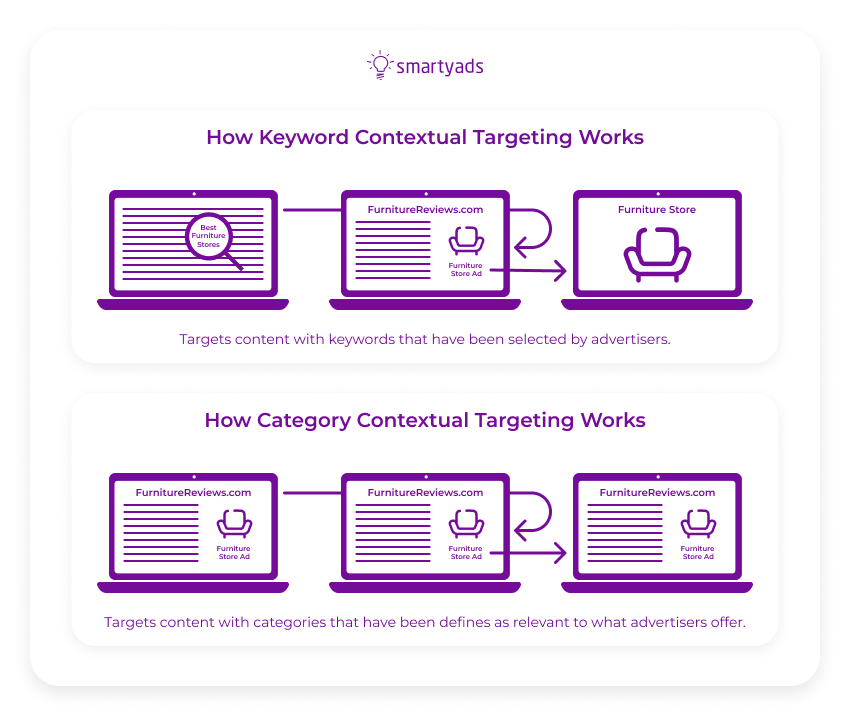
Most importantly, it helps run ad campaigns without third-party cookies, which is so important considering the California Consumer Privacy Act and General Data Protection Regulation.
Programmatic is a valuable resource for marketers in search of niche-specific ad targeting. AI algorithms can filter billions of web pages for keywords in a split second and select the most relevant ones.
In-Depth Semantic Analysis of Contextual Data
Analysis of text and page design, keywords, and language selects the most relevant pages to promote advertising. The in-depth content analysis enables even more meaningful audience participation.
A simple option is to search for keywords on the pages. A more complex one is to analyze the relations between words on the page for a deeper contextualization.
Real-time advertising algorithms analyze the URL of each page, check whether the site corresponds to a particular category, and analyze images, text, and keywords. Thus machine learning algorithms help to understand the full context of a page and if it is worth putting a brand message on it. It also removes pages that might be potentially harmful to the brand. For instance, those that include inappropriate content or hateful comments.
This process is called ontology. It's a comprehensive organization of language with all the concepts you need. AI makes contextual advertising effective by controlling all three levers: media, creatives, and targeting. The following contextual information is used for analysis:
- The page's category;
- Tone: negative or positive;
- Emotion. What is the mood of the content?
Targeting Tactic with AI
Programmatic targeting may be complemented by location, display time, user age, and other criteria. Programmatic advertising also recognizes gender, age, and other important identifiers that would make targeting difficult.
AI in programmatic can adjust campaign parameters as it analyzes its efficiency and even does so automatically.
Many marketers have high hopes for innovations in contextual targeting that will open up new opportunities to reach potential customers in a post-cookie world.
Sum Up
The future of contextual targeting is bright. Contextual targeting has always been effective, but nowadays, the potential of programmatic opens up new opportunities. Programmatic advertising is the quickest way to adapt to the evolving digital landscape. It offers advertisers the valuable advantages of new technologies and the choice of correct advertising partners. It's a new level for marketing campaigns.
Set up ad campaigns with Smartyads DSP!

